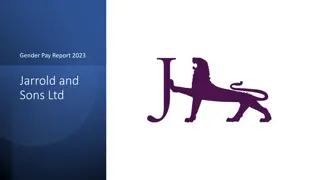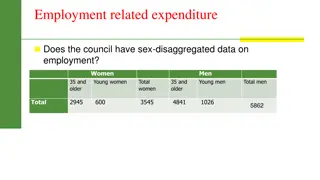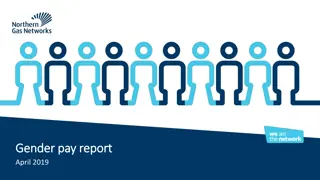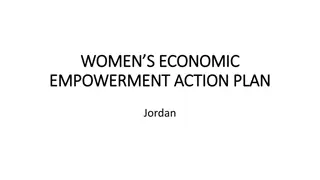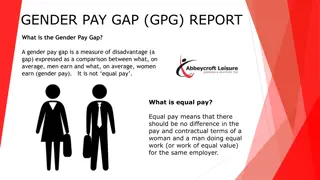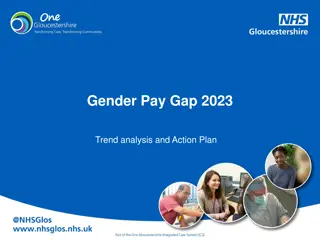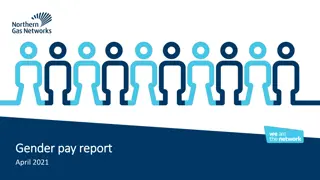Gender Pay Gap Analysis in Jordan: Trends and Sector Disparities
This paper delves into the gender pay gap (GPG) in Jordan, analyzing data from the 2011 Employment and Compensations survey. It explores the factors contributing to the GPG within various sectors and occupations, emphasizing the persistent structural issue despite some narrowing over the years. The study highlights disparities between the public and private sectors, shedding light on the need for addressing inequalities in pay.
Download Presentation

Please find below an Image/Link to download the presentation.
The content on the website is provided AS IS for your information and personal use only. It may not be sold, licensed, or shared on other websites without obtaining consent from the author.If you encounter any issues during the download, it is possible that the publisher has removed the file from their server.
You are allowed to download the files provided on this website for personal or commercial use, subject to the condition that they are used lawfully. All files are the property of their respective owners.
The content on the website is provided AS IS for your information and personal use only. It may not be sold, licensed, or shared on other websites without obtaining consent from the author.
E N D
Presentation Transcript
Fifth Global Forum on Gender Statistics Aguascalientes, Mexico, 3 - 5 November 2014 Equal Pay for Equal Work? A Look at the Pay Gap between Men and Women in Jordan Manal Sweidan Gender Statistics Expert 1
Introduction This paper presents the latest statistical data on gender pay gaps (GPG) in Jordan Data are drawn from the annual survey Employment and Compensations of Employees carried out by the Department of Statistics (DoS) in year 2011. It explores particular factors that reflects inequalities at work, such as variations in the width of the GPG within occupations, industries, sectors and level of education. The Gender pay gap is calculated using this formula: GPG= [men s average earnings women s average earnings] men s average earnings 2
Why address the Gender Pay Gap? Over the last three decades Jordan has made substantial investments in its human resources Life expectancy by Sex 74.4 2011 71.6 Female 66 Male 1980 63 60 65 70 75 Years 3
Why address the Gender Pay Gap?.cont Participation Rate of Jordanians Aged 15+ Years, by Sex Thus, the gains in human development have not been matched by an increase in women s economic participation The 11.7 % monthly GPG is a proxy for the lost productivity of employed women Women who are not employed to their full potential represent more than just a Pay Gap they represent a productive gap 76.3 70 75 66.1 64.462.8 Participation Rate % 60 45 30 14.714.7 11.6 12.3 15 6.4 0 1975 1985 1995 2005 2015 Male Female 4
Overall GPG Trends Although, the gender-based difference in pay has narrowed during the last two decades, it is still a major structural problem in the Jordanian labor market Pay Gap in Monthly Earnings 1992-2011 Monthly GPG 20.00 18.00 16.00 Monthly GPG % 14.00 12.00 10.00 8.00 6.00 4.00 2.00 0.00 1992 2000 2008 2011 5
GPGs across sectors Data indicates that the pay system is modular and less discriminatory in the public sector, in comparison with the private sector Monthly and Hourly PGs by Sectors, 2011 5.2 Public Sector 10.2 GPG % 9.4 Private Sector 19.5 0 5 10 15 20 Private Sector 9.4 Public Sector 5.2 Hourly GPG Monthly GPG 19.5 10.2 6
Monthly & Hourly GPGs across Occupations Monthly GPG Hourly GPG Elementary occupations Plant & machine operators & assemblers Craft & related trade workers Service workers, shop & market sales Clerks Technicians & associate professionals Professionals Legislators, senior officials & managers GPG % -20 0 20 40 60 80 7
GPGs across Educational levels The monthly and hourly GPGs are larger for university graduates than it is for graduates of community colleges, high school, or below 37.6 40 32.9 35 29.5 30 24.5 25 16.5 20 15 10 GPG % 2.6 5 0 Secondary or Middle Diploma 2.6 16.5 B.A/B.Sc or Higher Less than Secondary Hourly GPG Monthly GPG 32.9 37.6 24.5 29.5 8
GPG across the Feminized Industrial Activities The monthly and hourly pay gaps were much wider in manufacturing industry compared with education and health Monthly GPG (%) Hourly GPG (%) Share of Employment (%) Human Health and Social Work Activities Education Manufacturing 9 0 20 40 60 80 100
Conclusions The results of this paper lead us to an important question: Are these pay gaps due to choices women make in the workplace or to choices made FOR women in the workplace?. Consequently, the important question that needs to be answered: Could the gender pay gap turn out to be zero?. The 2010 OECD report has an answer which states that: trimming the workplace gender gap by half could significantly lift GDP growth rates . 10
Conclusions..cont Eventually, The issue is not only about pay or rely on the famous belief which states that: the most important step in closing the pay gap is to give up the notion that, to be paid fairly, a woman must make it in a man s world. but the opportunities for advancement and promotion that bring higher earnings. 11




